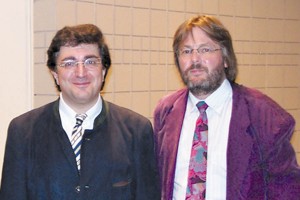George Warren
Staff Writer

Pianist Sergei Babayan has nothing to prove to his fans in Fresno. He’s been here many times before and has shown extreme range of emotion, total command of the keyboard, and a musical vision that goes well beyond the idea of mere entertainment.
Babayan drew a full house to the Concert Hall at California State University, Fresno, Sunday to open the season of the Philip Lorenz Memorial Keyboard Concert series. The CSUF Armenian Studies Program co-sponsored the recital.
Rather than putting on a tour-de-force of pianism as he has in the past, Babayan brought a program that focused on the spiritually expressive potential of his instrument. Opening with “Fur Alina” by Arvo Part is an unusual way to draw in an audience. This music is quiet and slow, and the harmony changes little throughout the brief span of the composition. In the hands of Babayan, what might be just a few notes turns into a timeless experience of speechless beauty. Babayan was in no hurry to finish phrases or get on with the piece. He allowed space to breathe, and he allowed time for notes to recede to silence. While the composition might not be groundbreaking in terms of harmony and rhythm, the singular feel of the music sets Part in his own camp of living composers.
As the last notes faded, the audience sat spellbound. There would be no applause here, the magic would have evaporated. After a moment of complete silence, Babayan began Liszt’s Ballade No. 2, the loudest and most dynamically expressive music on the program. Babayan demonstrated his understanding of the music by creating the wash of sound in the background and then bringing the themes out front.
His demeanor here was not filled with excitement and energy. Instead, he took the tone of presenting a sober moment of truth from Liszt’s oeuvre. This is no slouch of a piece of music, but the unfolding harmony sounds like something Moses might have written were he a composer.
Brahms’ Theme and Variations in D Minor, an arrangement from his String Sextet Op. 18, provided a brief diversion from the serious nature of the program, and Babayan seemed to enjoy the rolling chords and various treatments of the themes. He also delivered Liszt’s passionate setting of two Schubert songs with a clear eye on the meaning of the program.
The first half of the program ended with Schumann’s Variations on a Theme by Beethoven. The theme comes from Beethoven’s Seventh Symphony, and Schumann presents it unabridged the first time. Then Schumann’s imagination takes over, and while his development of the idea does not match Beethoven’s in immediate appeal, the growth of the idea to the stunning and riveting summation transforms Beethoven’s more primitive musical constraints into seminal material for Arvo Part.
The end of the set matched the beginning, with Babayan unwinding Schumann’s melody and countermelody over an unchanging harmony. It took a few seconds after the end for the audience to realize that it was time to applaud.
The second half featured the Suite in A Minor of Jean-Philippe Rameau, the great 17th-century theorist who wrote the book on tonal harmony and sealed the modal system into its churchyard grave. While Rameau the composer has achieved the following of Bach or Vivaldi, his music belongs in the same museum, as the other Baroque masters. After all, it was Rameau who put into words the argument for a functional tonal system.
How this fits into a program of highly emotional music is clear. Without the foundation of Rameau and the other Baroque composers, the music of Part, Brahms, and Schumann would not have been possible. Moreover in the hands of Babayan, this “intellectual” music of Rameau becomes as spiritually profound and expressive as the other music on the program. Maybe it’s not era or the style, maybe it’s that some compositions than others elevate the spirit of the listener.
Certainly, when Babayan is the pianist, the music is going to reach the heart of the audience.
George Warren, Ph.D., directs the music program at Hallmark Charter School.
 Hye Sharzhoom Armenian Action
Hye Sharzhoom Armenian Action